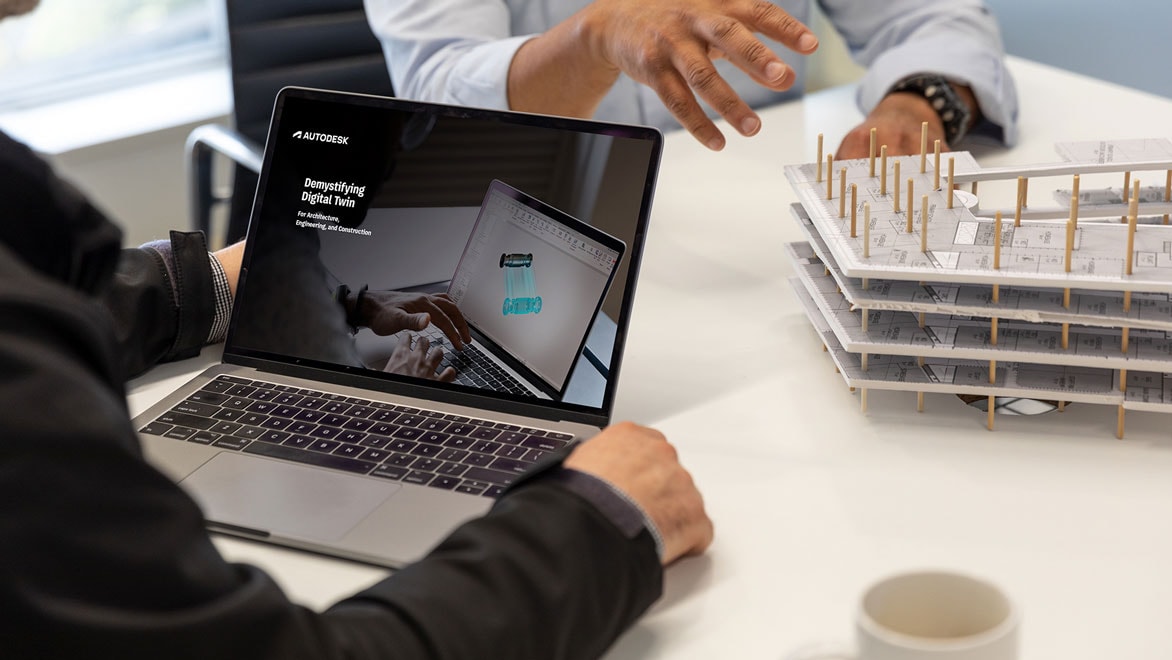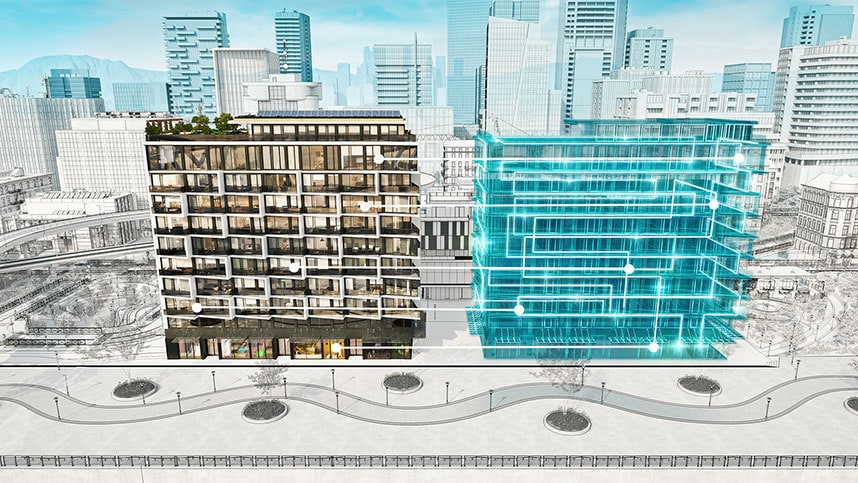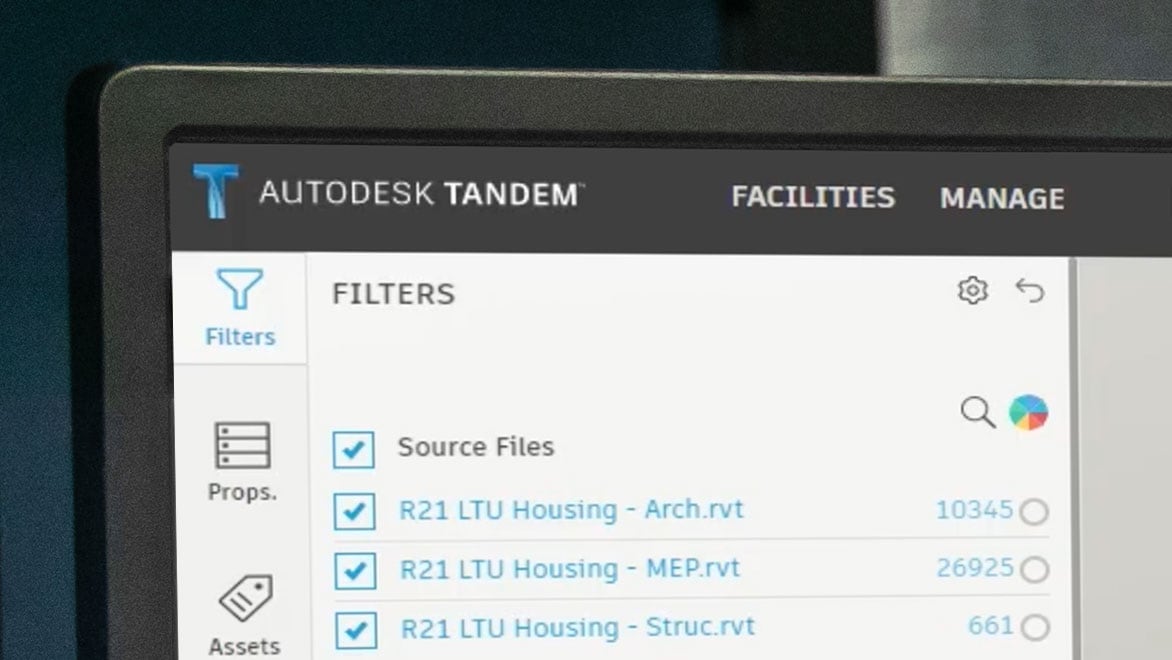Digital Twins in Construction, Engineering & Architecture
For the AEC industry, a digital twin integrates real-time data from a built asset with its digital representation to create insights across the project lifecycle.

Learn what digital twin can do for you
Digital twin isn’t just the latest shiny technology. It’s solving major challenges in both design and operations. Read our e-book to demystify digital twin, find out the real benefits for AEC firms and building owners, and discover why you should invest in it, sooner rather than later.
Digital twin is transforming AEC
Owners and operators gain insights to continually improve building performance.

What are the benefits of digital twin?
Digital twins give multi-dimensional views into how an asset is designed and how it’s performing, including occupant behavior, use patterns, space utilization, and traffic patterns. A digital twin offers a means to test "what-if" scenarios, including the impact of design changes, weather disruptions, and security events. It collects substantial data under one environment.

How does digital twin work?
Digital twin works by integrating a building’s system, sensor, and utility meter data with intelligent multidimensional digital models. A true digital twin possesses the operational and behavioral awareness necessary to simulate, predict, and inform decisions based on real-world conditions.
BIM to digital twin (video: 42 sec.)
How do digital twins use BIM?
The BIM process incorporates data created during the planning and design phases. Digital twin extends data capture to the construction and operational phases of the asset—and can also inform planning and design for future projects.
Realizing the full promise of digital twin requires multidisciplinary models at the core and an integration of systems and data across workflows and between organizations. BIM is the most efficient path to the creation of an accurate, high-value digital twin.
Types of digital twins
Each type of digital twin requires a greater degree of maturity and digital transformation, offering increased value to your business.
-
Level 1: Descriptive twin
The descriptive twin is a visual replica with live, editable design and construction data, including 3D models and BIM.
-
Level 2: Informative twin
The informative twin uses increased integration with sensors and operations data for insights at any given time.
-
Level 3: Predictive twin
The predictive twin captures real-time data, contextual data, and analytics to identify potential issues.
-
Level 4: Comprehensive twin
The comprehensive twin leverages advanced modeling and simulation for potential future scenarios as well as prescriptive analytics and recommendations.
-
Level 5: Autonomous twin
The autonomous twin has the ability to learn and make decisions through artificial intelligence, while using advanced algorithms for simulation and 3D visualization.
Enhance connections with interoperability and digital twin
Autodesk believes that seamless connections between people and software lead to better collaboration, fearless innovation, and an open AEC software ecosystem. As a co-founder of buildingSMART, we help support openBIM® standards and adoption through technical and strategic guidance. As a member of the Open Design Alliance, we have access to their IFC toolkit, enabling us to integrate new versions as they become ratified.
We are similarly committed to interoperability in the development of digital twin. As a founding member of the Digital Twin Consortium, we help develop guidelines and requirements for new standards to maximize the benefits of digital twins.
Try Autodesk Tandem for free
Create a real-time digital reflection of a building and harness the data created during a project to help customers achieve more efficient operations, lower their maintenance costs, and maximize the value of their investments.

More on the advantages of digital twins
2D plans remain the industry-standard deliverable for construction documents. However, owners often also ask for BIM without any means to articulate what they actually need. The typical result? Project teams spend countless, unbillable hours updating models. At the end of the day, these models aren’t even useful to the owner because data is trapped in files. This analog and disconnected data is often an insurmountable challenge for owners and operators to monitor, manage, and fine-tune their asset. Now, a digital twin can finally solve this handover problem with all the data and insights at the owner and operator’s fingertips.
For a new-build facility, the digital twin lifecycle starts at the beginning of the project. Firms collaborate with owners to understand the desired operational outcomes and the data required to deliver those outcomes. As the BIM-based design and construction phases proceed, data is captured and mapped to the model using Tandem. At handover, the digital twin accurately reflects the building’s classified object and asset data.
Then the occupants move in and the digital twin begins its second phase of life, operations. The digital twin can be connected to other systems to collect operational performance data, and system models can be created to perform simulation.
For the AEC industry, a digital twin is in the form of the built asset. Take, for example, an office building and its digital twin. At the end of design and construction, there is an exact, digital replica of the entire building. The actual, physical building is mirrored as a “twin” in a digital, dynamic format. Unlike a digital model or a simulation, a digital twin isn’t static. Just as the final, completed office building changes with use, so does the digital twin. It is responsive and continues to evolve as more data is supplied to it, such as data from artificial intelligence (AI), sensors, or the Internet of Things (IoT).
- More business, better value—winning more work means providing a broader set of services to clients. Adoption of digital twin enables greater competitive differentiation and delivers more value to customers in the form of data.
- Time savings—upfront conversations and collaboration with owners help to prioritize the asset’s use and performance expectations, as well as determine types of data required to achieve those goals.
- Cost savings—with digital twin development in line with design and construction, a cohesive handover of data is possible.
- Time savings—owners and operators can begincan begin efficient operation of assets. Never worry about misplaced documents or indecipherable maintenance documents.
- Cost savings—informed decision-making extends the value and life cycle of assets.
- Energy savings—with performance data and analysis, operators can optimize energy consumption.
Related digital twin solutions
Water management elevated
Power digital twin and transformation initiatives with a unified data model that works across water management applications.
Connecting projects in context
ArcGIS GeoBIM delivers a web-based experience for teams to collaborate on BIM projects and issues using data from multiple systems in a geospatial context.